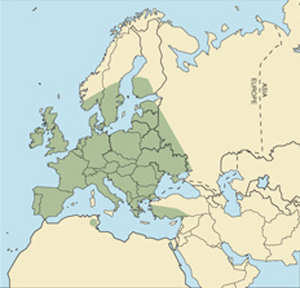|
Dama damaGamo (Sp), Damhirsch (G), Daim (F).
"Fallow" is from the Old English fealu, meaning a light yellowish-brown color. Sometimes called common fallow deer to distinguish it from the endangered Persian fallow deer (D. mesopotamica) of Iran.
DESCRIPTION (male) Shoulder height 36-43 inches (91-109 cm). Weight 140-220 pounds (64-100 kg), sometimes more. Females are smaller.Medium-sized, with more color variations than any other deer. The four principal ones are: (1) typical-summer coat of rich brown with white spots and lighter underparts, changing to dark gray-brown in winter with spots barely visible; (2) menil-pale fawn with white spots; (3) white (but not albino); and (4) black-not actually black, but very dark brown. There are many intermediate color variations. Antlers have brow and trez tines (bez tines are usually absent), and are well-palmated at the top, with a number of tines coming off the rear edge of the palmation.
BEHAVIOR Social behavior varies: in some areas gregarious, with herds as large as 30, but in other areas more or less solitary. Herds usually led by does, although there does not seem to be a dominance hierarchy. Males establish small territories during the rut, when they bellow and grunt and do a good deal of fighting while gathering harems. Mating season is in October, with the (usually) single fawn born in the spring.Diurnal, with most activity early and late in the day. Essentially a grazer, but also browses shrubs and trees. Vision, hearing and sense of smell are good. When alarmed, gives a short "bark" and runs off with stiff-legged bounces that serve as a warning. Not as wary or shy as most other deer; can easily be semi-domesticated if given supplemental feed and not hunted. Very hardy, able to live in a wide range of climatic and environmental conditions, but some forest seems to be required.
HABITAT Open woodland.
DISTRIBUTION Most of Europe. Commonly kept in deer parks.It is known from fossils that fallow deer, or something very similar, lived in many parts of Europe during the Pleistocene Epoch, but most (if not all) of them died out during the last glaciation when ice covered most of Europe. Modern fallow deer are thought to have originated in the Mediterranean region of southern Europe, the island of Rhodes, and Anatolia (Asian Turkey). Introduced (or reintroduced?) in most parts of Europe by the Romans, or perhaps by the earlier Phoenicians. For record-keeping purposes, all fallow deer from Europe are considered indigenous.Also native to Asian parts of Turkey. Introduced in North and South America, New Zealand, Australia, South Africa, and some oceanic islands. Found in the wild in 38 countries on six continents.
REMARKS For the best trophies, fallow deer should be hunted soon after the velvet is stripped, since tines are often broken off in fighting during the rut. The best antlers come from Denmark and Hungary, but other eastern European countries, and Spain, also produce good heads.
|




